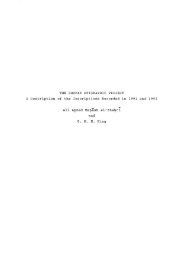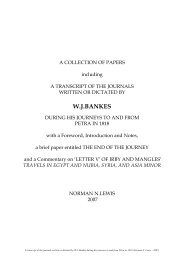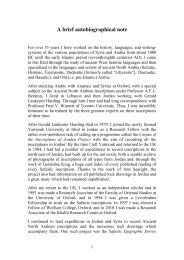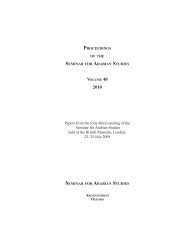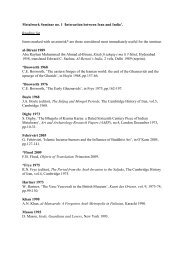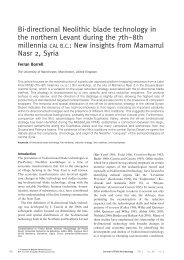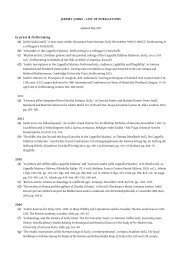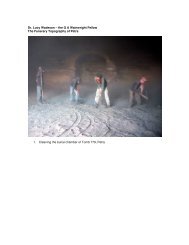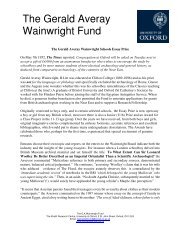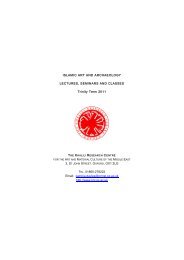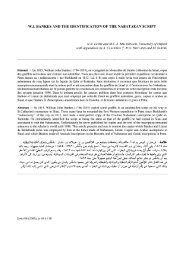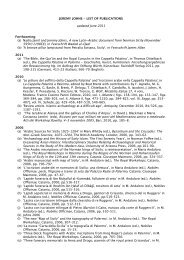Reflections on the linguistic map of pre-Islamic Arabia - Khalili ...
Reflections on the linguistic map of pre-Islamic Arabia - Khalili ...
Reflections on the linguistic map of pre-Islamic Arabia - Khalili ...
Create successful ePaper yourself
Turn your PDF publications into a flip-book with our unique Google optimized e-Paper software.
(<strong>on</strong> which we have much less data) will inevitably<br />
follow that <strong>of</strong> <strong>the</strong> scripts in which<br />
<strong>the</strong>y are habitually ex<strong>pre</strong>ssed, except<br />
where <strong>the</strong>re is evidence to <strong>the</strong> c<strong>on</strong>trary.<br />
There is an increasing recogniti<strong>on</strong> that<br />
<strong>the</strong> distincti<strong>on</strong> between <strong>the</strong> ‘Dedanite’ and<br />
‘Lihw yānite’ scripts is artificial and that <strong>the</strong>y<br />
re<strong>pre</strong>sent <strong>the</strong> same script at different stages<br />
<strong>of</strong> development. Moreover, <strong>the</strong> chr<strong>on</strong>ological<br />
limits <strong>of</strong> <strong>the</strong>se different stages do<br />
not necessarily coincide with <strong>the</strong> kingdoms<br />
<strong>of</strong> Dadan (see note 1) and Lihw yān, after<br />
which <strong>the</strong>y are named. However, if we<br />
aband<strong>on</strong> <strong>the</strong> term ‘Dedanite’ it would still<br />
be anachr<strong>on</strong>istic to talk <strong>of</strong> ‘Lihyanite’ before<br />
<strong>the</strong> kingdom <strong>of</strong> Lihw yān. It would seem<br />
to be more sensible to name <strong>the</strong> script (at<br />
all stages <strong>of</strong> its development) after <strong>the</strong> oasis<br />
in which it developed, ra<strong>the</strong>r than after a<br />
specific kingdom. I would <strong>the</strong>refore suggest<br />
that, from now <strong>on</strong>, <strong>the</strong> labels ‘Lihyanite’<br />
and ‘Dedanite’ be aband<strong>on</strong>ed and<br />
<strong>the</strong> script and language throughout <strong>the</strong>ir<br />
history be referred to as ‘Dadanitic’. It<br />
would <strong>the</strong>n be possible to distinguish different<br />
phases within <strong>the</strong> development <strong>of</strong><br />
<strong>the</strong> script (‘early’, ‘middle’, ‘late’, etc.)<br />
without tying <strong>the</strong>m to political events, <strong>the</strong><br />
dating <strong>of</strong> which is anyway uncertain.<br />
Similarly, I would refer to <strong>the</strong> scripts<br />
which developed in <strong>the</strong> oases <strong>of</strong> Taymā $<br />
and Dūmā (modern al-Jawf) as ‘Taymanitic’<br />
(30) and ‘Dumaitic’ (31) respectively.<br />
These terms would also refer to <strong>the</strong> dialects<br />
normally ex<strong>pre</strong>ssed by <strong>the</strong>se alphabets.<br />
The scripts <strong>of</strong> <strong>the</strong> Early Dadanitic, Taymanitic<br />
and Dumaitic texts, toge<strong>the</strong>r with<br />
those <strong>of</strong> <strong>the</strong> so-called ‘Chaldaean’ inscripti<strong>on</strong>s<br />
(<strong>of</strong> which more below) are very close<br />
in form, and it is <strong>of</strong>ten difficult to assign a<br />
short text to <strong>on</strong>e or o<strong>the</strong>r type (see Fig. 3).<br />
It <strong>the</strong>refore seems to me useful to think in<br />
terms <strong>of</strong> an ‘Oasis North <strong>Arabia</strong>n’ [ONA]<br />
script, which was employed, with small<br />
local variati<strong>on</strong>s in letter-form and orthographic<br />
practice, in <strong>the</strong> three major oasis-<br />
THE LINGUISTIC MAP OF PRE-ISLAMIC ARABIA<br />
towns <strong>of</strong> North <strong>Arabia</strong>: Dadan, Taymā $ and<br />
Dūmā, and probably also am<strong>on</strong>g <strong>the</strong> Arab<br />
communities settled in Babyl<strong>on</strong>ia and elsewhere<br />
(32). I would suggest that Oasis<br />
North <strong>Arabia</strong>n be subdivided into Dadanitic,<br />
Taymanitic, etc. <strong>on</strong>ly when <strong>the</strong>re is<br />
clear evidence to justify this (33).<br />
A new name is also urgently needed for<br />
<strong>the</strong> so-called ‘Chaldaean’ inscripti<strong>on</strong>s, <strong>the</strong><br />
brief texts in <strong>the</strong> ONA script, <strong>on</strong> seals, pottery,<br />
bricks, etc. which have been found in<br />
various parts <strong>of</strong> Mesopotamia and elsewhere<br />
(34). They are clearly in no sense<br />
‘Chaldaean’ (35) and Burrows’ descripti<strong>on</strong><br />
<strong>of</strong> <strong>the</strong> script as ‘Old Arabic’ is equally misleading<br />
(36). While it is likely, although in<br />
most cases unprovable, that at least some<br />
<strong>of</strong> <strong>the</strong>se texts are to be associated with <strong>the</strong><br />
Arab communities settled in Babyl<strong>on</strong>ia,<br />
o<strong>the</strong>rs appear to be c<strong>on</strong>nected with Syria<br />
and Transjordan (37), and yet o<strong>the</strong>rs seem<br />
to be from <strong>Arabia</strong> itself (38). They <strong>the</strong>refore<br />
do not form a homogeneous group. I<br />
would suggest that this be reflected in a descriptive<br />
term such as ‘dispersed Oasis<br />
North <strong>Arabia</strong>n inscripti<strong>on</strong>s’, failing a<br />
more c<strong>on</strong>cise and elegant title.<br />
The name ‘Thamūdic’ was <strong>the</strong> inventi<strong>on</strong><br />
<strong>of</strong> western scholars even though <strong>the</strong>re is<br />
virtually no evidence to c<strong>on</strong>nect any <strong>of</strong> <strong>the</strong><br />
texts ga<strong>the</strong>red under this rubric with <strong>the</strong><br />
ancient tribe <strong>of</strong> Thamūd (39). However, <strong>the</strong><br />
label is far too well established to be<br />
changed and its very inappropriateness,<br />
when recognized, serves to emphasize <strong>the</strong><br />
artificiality <strong>of</strong> <strong>the</strong> category. For ‘Thamudic’<br />
is no more than a Restklassenbildung (a term<br />
I owe to E. A. Knauf, ZDPV 97, 1981; 189,<br />
n. 7), a sort <strong>of</strong> undetermined’ pige<strong>on</strong>-hole<br />
into which <strong>on</strong>e can put everything which<br />
does not fit into <strong>on</strong>e <strong>of</strong> <strong>the</strong> better-defined<br />
categories. In a field such as Ancient North<br />
<strong>Arabia</strong>n, in which so much <strong>of</strong> <strong>the</strong> evidence<br />
is uncertain and so much work still needs<br />
to be d<strong>on</strong>e, this serves a useful purpose.<br />
However, while this is, or should be,<br />
33



